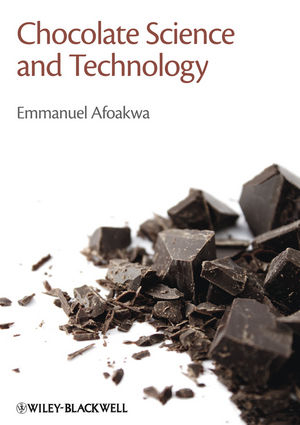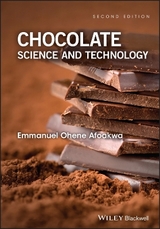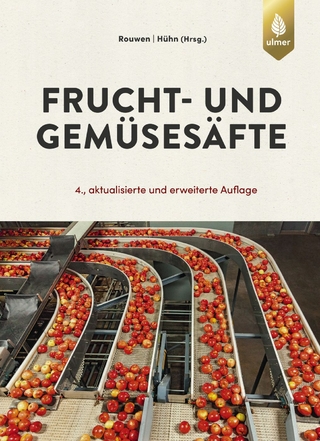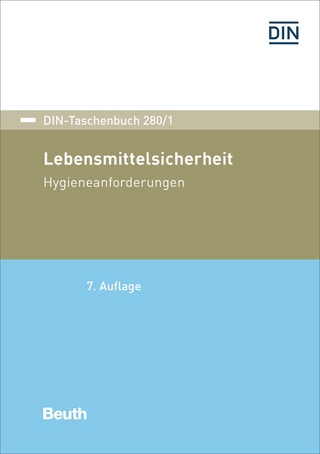
Chocolate Science and Technology
Wiley-Blackwell (an imprint of John Wiley & Sons Ltd) (Verlag)
978-1-4051-9906-3 (ISBN)
- Titel erscheint in neuer Auflage
- Artikel merken
There is a focus throughout on those factors that influence the flavour and quality characteristics of the finished chocolate and that provide scope for process optimization and improvement. The book is designed to be a desk reference for all those engaged in the business of making and using chocolate worldwide; confectionery and chocolate scientists in industry and academia; students and practising food scientists and technologists; nutritionists and other health professionals; and libraries of institutions where food science is studied and researched. * an overview of the science behind chocolate manufacture * covers the whole process from cocoa production, through manufacturing, to the nutrition and health aspects of chocolate consumption * focuses on factors that influence chocolate flavour and quality, and that provide scope for process optimization and improvement.
Preface Acknowledgements About the author 1 Chocolate production and consumption patterns 1.1 History of cocoa and chocolate 1.2 World production and consumption of cocoa and chocolate products 1.2.1 World production and consumption of cocoa 1.2.2 World cocoa prices 1.2.3 World consumption of chocolate products 1.2.4 World consumption of premium chocolate products 1.3 Fairtrade cocoa and chocolate in modern confectionery industry 1.3.1 Future of Fairtrade cocoa and confectionery industry 1.4 The concept of this book 2 Cocoa cultivation, bean composition and chocolate flavour precursor formation and character 2.1 Introduction 2.2 Cocoa cultivation and practices 2.2.1 Cultivation of cocoa 2.2.2 Flowering and pod development 2.2.3 Harvesting and pod opening 2.2.4 Cocoa diseases and pests and their influence on chocolate quality 2.3 Bean composition and flavour precursor formation 2.3.1 Chemical composition of the bean 2.3.2 Polyphenols and chocolate flavour quality 2.3.3 Effects of proteins and sugars on flavour precursor formation 2.3.4 Microbial succession and enzymatic activities during flavour precursor generation in cocoa fermentation 2.4 Effect of genotype on cocoa bean flavours 2.5 Flavour development during post-harvest treatments of cocoa 2.5.1 Fermentation processes 2.5.2 Drying 2.6 Conclusion 3 Industrial chocolate manufacture processes and factors influencing quality 3.1 Introduction 3.2 Cocoa processing and technology 3.2.1 Bean selection and quality criteria 3.2.2 Cleaning, breaking and winnowing 3.2.3 Sterilisation 3.2.4 Alkalisation 3.2.5 Roasting 3.2.6 Nib grinding and liquor treatment 3.2.7 Liquor pressing 3.2.8 Cake grinding (kibbling) 3.2.9 Cocoa powder production 3.3 Chocolate manufacturing processes 3.3.1 Mixing 3.3.2 Refining 3.3.3 Conching 3.4 Tempering, lipid crystallisation and continuous phase character during chocolate manufacture 3.5 Particle size distribution in chocolate 3.6 Compositional effects on rheological and textural qualities in chocolate 3.6.1 The role of fats 3.6.2 The role of sugar 3.6.3 The role of milk and other dairy components 3.6.4 The role of surfactants in modern chocolate confectionery 3.7 Moisture and chocolate flow 3.8 Chocolate quality and defects 3.8.1 Chocolate quality 3.8.2 Chocolate defects 3.9 Conclusion and further research 4 The chemistry of flavour development during cocoa processing and chocolate manufacture 4.1 Introduction 4.2 Influence of bean selection on chocolate flavour quality 4.3 Effect of roasting 4.3.1 Maillard reactions aldol condensation, polymerisation and cyclisation 4.3.2 Effects of alkalisation 4.4 Flavour development during chocolate manufacture 4.4.1 Conching 4.5 Key flavour compounds in milk chocolate 4.6 Key flavour compounds in dark chocolate 4.7 Conclusion 5 Sensory character and flavour perception of chocolates 5.1 Summary and industrial relevance 5.2 Introduction 5.3 Sensory perception of quality in chocolates 5.3.1 Appearance 5.3.2 Texture 5.3.3 Taste 5.3.4 Flavour and aroma 5.4 Sensory assessment of chocolates 5.5 Factor influencing chocolate flavour 5.6 Flavour release and perception of sweetness in chocolate 5.7 Dynamism of flavour perception in chocolate 5.8 Retronasal flavour release and perception during chocolate consumption 5.9 Measurement of flavour release and intensity in chocolates 5.10 Electronic noses and tongues as online sensors for sensory assessment of chocolates 5.11 Conclusion 6 Nutritional and health benefits of cocoa and chocolate consumption 6.1 Summary and significance 6.2 Introduction 6.3 Chemistry and composition of cocoa flavonoids 6.4 Chocolate types and their major nutritional constituents 6.5 Antioxidant properties and their mechanism of action 6.6 Effects on endothelial function, blood pressure and cardiovascular system 6.7 Effects on insulin sensitivity and carcinogenic properties 6.8 Cocoa, chocolate and aphrodisiac properties 6.9 Conclusion 7 Structure properties (rheology, texture and melting) relationships in chocolate manufacture 7.1 Summary and industrial relevance 7.2 Introduction 7.3 Materials and methods 7.3.1 Materials 7.3.2 Preparation of chocolate samples 7.3.3 Determination of particle size distribution 7.3.4 Rheological measurements 7.3.5 Tempering procedure 7.3.6 Texture measurements 7.3.7 Colour measurements of solid dark chocolate 7.3.8 Microstructure analysis 7.3.9 Determination of melting properties of dark chocolates 7.3.10 Experimental design and statistical analysis 7.4 Results and discussion 7.4.1 Particle size distribution of molten dark chocolate 7.4.2 Rheological properties of molten dark chocolate 7.5 Relationships between casson model and ICA recommendations 7.6 Textural properties 7.6.1 Molten dark chocolate 7.6.2 Hardness of tempered dark chocolate 7.6.3 Colour measurements 7.6.4 Relationships between textural properties and appearance of dark chocolate 7.7 Microstructural properties of molten dark chocolate 7.8 Melting properties of dark chocolate 7.8.1 Effects of particle size distribution 7.8.2 Effects of fat content 7.8.3 Effects of lecithin 7.9 Relationships between rheological, textural and melting properties of dark chocolate 7.10 Conclusion 8 Tempering behaviour during chocolate manufacture: effects of varying product matrices 8.1 Summary and industrial relevance 8.2 Introduction 8.3 Materials and methods 8.3.1 Materials 8.3.2 Tempering procedure 8.3.3 Determination of particle size distribution 8.3.4 Experimental design and statistical analysis 8.4 Results and discussion 8.4.1 Particle size distribution of dark chocolates 8.4.2 Effect of particle size distribution on tempering behaviour 8.4.3 Effect of fat content on tempering behaviour 8.5 Conclusion 9 Tempering and fat crystallisation effects on chocolate quality 9.1 Summary and industrial relevance 9.2 Introduction 9.3 Materials and methods 9.3.1 Materials 9.3.2 Determination of particle size distribution 9.3.3 Tempering experiment 9.3.4 Texture measurements 9.3.5 Colour and gloss measurements 9.3.6 Image acquisition and capture 9.3.7 Determination of melting properties 9.3.8 Microstructural determinations 9.3.9 Scanning electron microscopy 9.3.10 Experimental design and statistical analysis 9.4 Results and discussion 9.4.1 Particle size distribution of dark chocolates 9.4.2 Fat crystallisation behaviours during tempering of dark chocolate 9.4.3 Effect of temper regime and PSD on mechanical properties 9.4.4 Effect of temper regime and PSD on colour and gloss 9.4.5 Effect of temper regime and PSD on melting properties 9.4.6 Effect of temper regime on microstructure 9.4.7 Effect of temper regime on scanning electron microstructure 9.5 Conclusion 10 Fat bloom formation and development in chocolates 10.1 Summary and industrial relevance 10.2 Introduction 10.3 Materials and methods 10.3.1 Materials 10.3.2 Determination of particle size distribution 10.3.3 Tempering experiment 10.3.4 Texture measurements 10.3.5 Surface colour and gloss measurements 10.3.6 Determination of melting properties 10.3.7 Microstructural determinations 10.3.8 Experimental design and statistical analysis 10.4 Results and discussion 10.5 Conclusion 11 Matrix effects on flavour volatiles character and release in chocolates 11.1 Summary and industrial relevance 11.2 Introduction 11.3 Materials and methods 11.3.1 Materials 11.3.2 Tempering procedure 11.3.3 Determination of particle size distribution 11.3.4 Quantification of flavour volatiles by gas chromatography 11.3.5 Gas chromatography olfactometry analytical conditions 11.3.6 Experimental design and statistical analysis 11.4 Results and discussion 11.4.1 Particle size distribution of dark chocolates 11.4.2 Characterisation of flavour compounds in dark chocolates 11.4.3 Effects of particle size distribution on flavour volatile release 11.4.4 Effects of fat content on flavour volatile release 11.4.5 Relating flavour volatiles release to PSD and fat content: product spaces 11.5 Conclusion 12 Conclusions and industrial applications 12.1 Conclusions: Structure properties relationships in chocolate manufacture 12.2 Conclusions: Tempering behaviour from response surface methodology 12.3 Conclusions: Effects of tempering and fat crystallisation on microstructure and physical properties 12.4 Conclusions: FAT bloom formation and development with undertempering 12.5 Conclusions: Flavour volatiles and matrix effects related to variations in PSD and FAT content 12.6 Industrial relevance and applications of research findings in this book 12.7 Recommendations for further research studies References Appendix 1: Abbreviations used and their meanings Appendix 2: Abbreviations, acronyms and websites of organizations related to cocoa and chocolate industry Appendix 3: Glossary of chocolate terminologies Index
| Zusatzinfo | Illustrations |
|---|---|
| Verlagsort | Chicester |
| Sprache | englisch |
| Maße | 177 x 251 mm |
| Gewicht | 906 g |
| Themenwelt | Technik ► Lebensmitteltechnologie |
| Weitere Fachgebiete ► Land- / Forstwirtschaft / Fischerei | |
| ISBN-10 | 1-4051-9906-7 / 1405199067 |
| ISBN-13 | 978-1-4051-9906-3 / 9781405199063 |
| Zustand | Neuware |
| Informationen gemäß Produktsicherheitsverordnung (GPSR) | |
| Haben Sie eine Frage zum Produkt? |
aus dem Bereich



